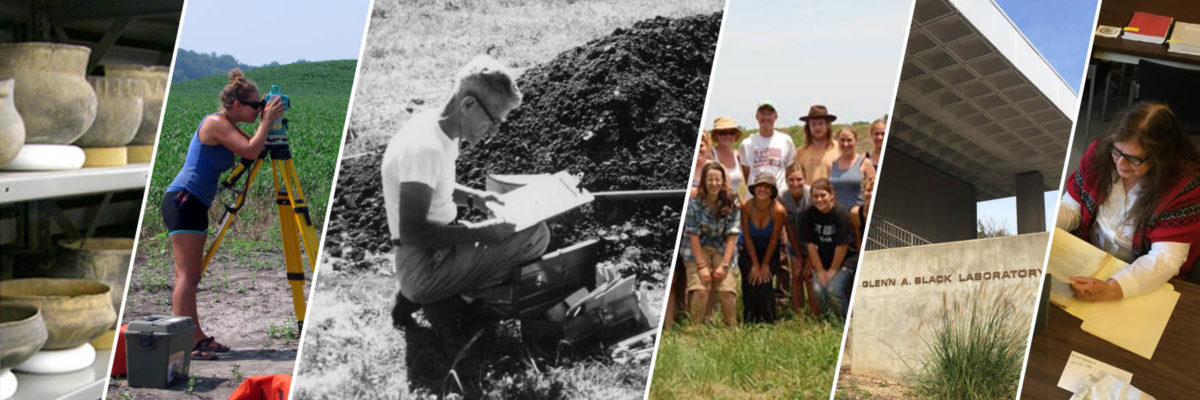November 1, 2016
by Hannah Rea, Social Media Intern
Recently, I sat down with Melody Pope, Curator of Collections for the Glenn A. Black Laboratory of Archaeology (GBL), who is nearing the one-year anniversary holding the position. She describes the job as one of oversight and stewardship, since she is in charge of complying with curation agreements the GBL has made with federal agencies and managing the collection, among other things.
Pope has had a long relationship with Indiana and the GBL. Born and raised in southern Indiana, she worked at the GBL during her time as an undergraduate student at Indiana University, and said that this link is part of what attracted her to the position, seeing it as an opportunity to return to the Hoosier State. This new job was not only a geographical shift from her previous position at the University of Iowa, but also a career shift.
Much of Pope’s previous work has been in compliance archaeology, programs that operate under the National Historic Preservation Act and various state and local guidelines to survey land considered for development, and ensure the work will not disturb any archaeological sites.
“It’s doing archaeology for historical preservation,” Pope said. “Now I’m in more of a museum-kind of position.”
One skill she has utilized throughout her career is photography.
“I’ve always had an interest in photography as a hobby,” she said. “It was a skill I was able to build and utilize in my work.”
Pope began in film photography, and was the designated photographer on three archaeological expeditions to Iraq during her time as a doctoral student at Binghamton University.
“It was a lot of fun to be the photographer for the expedition,” she said. “I never in a million years imagined I would go to Iraq and do archaeology.”
Pope traveled to the country in the late 1980s and early 1990s. While there, the American and British archaeologists on the team lived on site in field camps: “Living archaeology 24/7. It’s fun if you like roughing it.”
She said it was relatively easy to get the correct permits from the Iraqi government, though there still was plenty of red tape to get through. There was a representative from the Department of Antiquities constantly overseeing the progress, but otherwise, Pope said, the experience was not too different from doing archaeology here.
“We got back and within two weeks, Saddam Hussein had invaded Kuwait and started the First Gulf War,” Pope recalled.
As for the current situation in Iraq and surrounding countries, many archaeologists are working to make people aware of how manipulative governments can be of archaeological finds. The manipulation of archaeology to create ideologies about a past the governments want people to believe often leads to the destruction of historical sites and artifacts.
“I think a lot of anthropological archaeologists are becoming activists in their work,” Pope said.
Some devote their time and energy to work like investigating war crimes and excavating mass graves. Others take a different route: “A lot of folks simply shift their work into safer areas.”
“It’s been hard to get back over there and assess the damages,” she said. And though it’s important to preserve history, “People’s lives are more important than the past, when you get down to it.”
Preserving culture and bringing the human aspect back into focus is also part of the mission at the Glenn A. Black Lab.
“Early on, the lab was very much a central hub for Indiana archaeology.”
Like many similar institutions, inconsistent record-keeping practices have led to challenges for collections management today. After early excavations, many artifacts received only basic cataloguing, and some are even in the same bags they were put in when they were originally excavated in the 1940s, Pope said. The lab today is focused on balancing museum work to rehabilitate collections, create new exhibits and conduct research.
“With so much time having passed since most collections came into the lab it can be a real challenge to rehouse collections, to put things back together again,” she said. “We’ve got a lot of work cut out for us.”
The strong museum identity was part of the early mission of the GBL with over half of its square footage dedicated to storage and display of artifacts. The laboratory part of its identity comes with research and teaching opportunities that involve diverse scholars and stakeholders. The combined museum and research laboratory identity allows the GBL to serve double-duty as a place to conduct research, educate students and engage with communities interested in Ohio Valley archaeology and history.
“We’re collaborating more and more with the public,” Pope said. “It’s all integrated here, and it’s a really unique place.”

